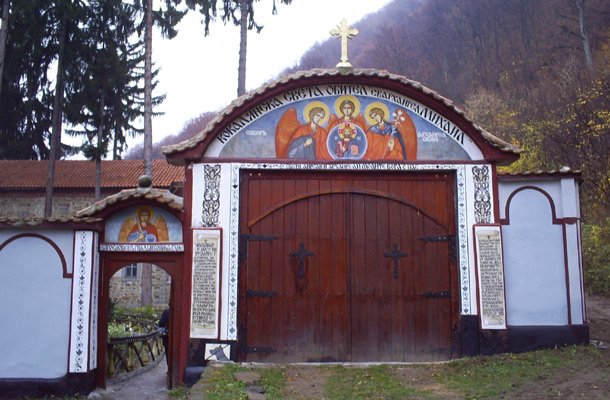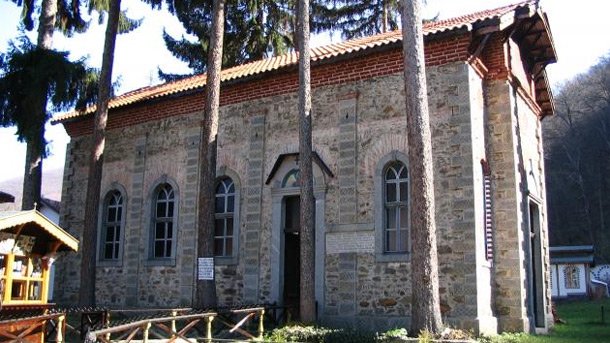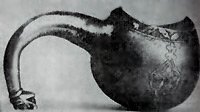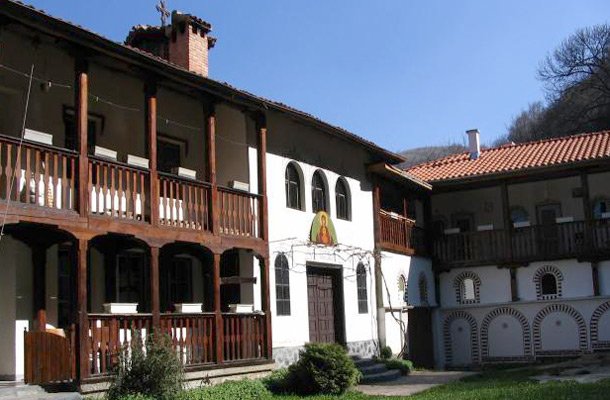The Kokalyane Monastery is situated at the foot of Plana Mountain, near the village of Kokalyane, some 10 km to the South of Sofia. One can walk to the place, using a steep forest path, starting from the Devil’s Bridge at the Sofia – Samokov road. A legend says that the Ottoman conquerors did a huge massacre of Christians here and the spot was covered with human bones /kokali in Bulgarian, hence the name Kokalyane/. The St. Michael Monastery was a part of the Sofia Mount Athos complex and his story is full of legends. According to one of them Tsar Samuil killed a roe here end-10th century and took that as some immolation. That happened on the day of St. Michael /archangel/ and the construction of the monastery kicked off then. Another legend says the Tsar Ivan Shishman of Bulgaria was taken by surprise at the monastery in the 14th century and killed by the Turks.

© Photo: archive
The monastery was built up with the courtesy of the Bulgarian rulers. It was a wealthy place with many lands belonging. It was quickly restored after the Ottoman occupation /end-14th century/ and attracted lots of pilgrims from the villages nearby. Perhaps some of the defenders of the Urvich fortress situated nearby took jewelries and old books to the monastery after its defeat…
The monastery was robbed and burnt down twice in the period of Ottoman domination. Its existence was documented in the Kokalyane Compilation in 1645. It consisted of a small church and two rooms and Father Stoine was the abbot. The Turks butchered his brother during a raid, since he didn’t want to tell them where the abbot was hiding. The St. Michael Church was built up on the place, where the old temple had existed. The spot was abandoned up until 1858 due to outlaws’ attacks, when monk Hrisant from the Rila Monastery restored it. Bands of Turkish army deserters killed the monk in 1868 and his grave can be found nowadays at the yard’s entrance. The monastery was abandoned once again and was again restored mid-1870s. In 1896 the old frame-built church was demolished and the current stone building was constructed with donations of the locals. It is situated in the middle of the yard and the icons inside have been donated by people from the village of Zheleznitsa.

The legend says that the treasures of the last Bulgarian Tsar Ivan Shishman were hidden in the Kokalyane Monastery. Those, who discovered them, found precious manuscripts among them – old Slavonic parchment books, which were later taken to the Rila Monastery. Paisius of Hilendar also mentioned in his 1762 Istoriya Slavyanobolgarskaya that the treasures of Ivan Shishman had been taken to the Rila temple.

The legend tells the stories of two precious relics from the Second Bulgarian Empire, related to its last tsar – Ivan Shishman. Those were a silver gourd and a crystal glass with gold inlay. The silver gourd was brought from the Urvich fortress, along with other treasures. A postulant with the monastery broke a precious crystal glass in 1870 that was also covered with gold inlay – flowers, as the gold was infused in the glass – the famous Venetian glass technique.
Precious books were preserved at the Kokalyane Monastery too. The remarkable Kokalyane Compilation was created here in the 16th century. Half of it is in the form of a beadroll, started as of 1654, containing data on all prigrims and their donations to the temple. The so-called Kokalyane Gospel was written here in 1579.

The monastery is very well maintained today, it consist of a St. Michael temple and two chapels. A third chapel was built up a few years ago, dedicated to Deacon Stefan. The place is open for visits every day. The yard is full of pilgrims on November 8, St. Michael’s Day and on August 15 – the Day of Mother Mary.
The Kokalyane Monastery is also a favorite place for tourism. It was declared a cultural monument back in 1969.
Written by: Associate Professor Dr. Valentina Dineva, Institute for Ethnology and Folklore Studies with the Ethnography Museum with the Bulgarian Academy of Sciences
English version: Zhivko Stanchev
Beloslav is a small town on one of the branches of Varna Lake. Yet it is here, in this quiet little town, that the only preserved Bulgarian submarine – Slava – is anchored . It was decommissioned a long time ago, and has now been turned in one of..
March 9 is the feast day of the Church of the Forty Martyrs in the town of Veliko Tarnovo - a place of exceptional importance for the Bulgarian statehood, which worthily preserves the memory of the glorious Tarnovo kings. On March 9, the..
Father Lyubomir Leontinow is one of three priests at the Cathedral of St Boris the Conqueror in Berlin and was the first priest ordained for the Western and Central European Diocese in 1994. After completing his theology studies in Bulgaria, he settled..
Beloslav is a small town on one of the branches of Varna Lake. Yet it is here, in this quiet little town, that the only preserved Bulgarian submarine..

+359 2 9336 661
